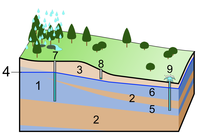
Photo from wikipedia
The Central Andes of northern Chile host many large porphyry copper deposits (PCDs)—hydrothermally generated, sulfide-bearing orebodies centered on felsic to intermediate igneous intrusions (Richards, 2013). Initially formed at depths of… Click to show full abstract
The Central Andes of northern Chile host many large porphyry copper deposits (PCDs)—hydrothermally generated, sulfide-bearing orebodies centered on felsic to intermediate igneous intrusions (Richards, 2013). Initially formed at depths of ∼1–4 km (Sillitoe, 2010), many PCDs have been exhumed to the (near-)surface following the late Eocene Incaic orogeny (Riquelme et al., 2018). The economic metal concentrations of some exhumed PCDs were produced during weathering, via meteoric water-driven “supergene” (from Abstract The Atacama Desert, on the western margin of the Central Andes, hosts some of the world's largest porphyry copper deposits (PCDs). Despite a hyperarid climate, many of these PCDs have undergone secondary “supergene” enrichment, whereby copper has been concentrated via groundwaterdriven leaching and reprecipitation, yielding supergene profiles containing valuable records of weathering and landscape evolution. We combine hematite (U-Th-Sm)/He geochronology and oxygen isotope analysis to compare the weathering histories of two Andean PCDs and test the relative importance of climate and tectonics in controlling both enrichment and water table movement. At Cerro Colorado, in the Precordillera, hematite precipitation records prolonged weathering from ∼31 to ∼2 Ma, tracking water table descent following aridity-induced canyon incision from the late Miocene onward. By contrast, hematite at Spence, within the Central Depression, is mostly younger than ∼10.5 Ma, suggesting exhumation ended much later. A heavy oxygen isotopic signature for Spence hematite suggests that upwelling formation water has been an important source of groundwater, accounting for a high modern water table despite persistent hyperaridity, whereas isotopically light hematite at Cerro Colorado formed in the presence of meteoric water. Compared with published paleo-environmental and sedimentological records, our data show that weathering can persist beneath appreciable post-exhumation cover, under hyperarid conditions unconducive to enrichment. The susceptibility of each deposit to aridity-induced water table descent, canyon incision and deep weathering has been controlled by recharge characteristics and morphotectonic setting. Erosional exhumation, rather than aridity-induced water table decay, appears to be more important for the development of supergene enrichment.
Journal Title: Geochemistry, Geophysics, Geosystems
Year Published: 2021
Link to full text (if available)
Share on Social Media: Sign Up to like & get
recommendations!